I have been reading a lot about the agitations going on regarding the quota system. I have a very simple suggestion for this about which I don't seem to have read any where.
The quota system (reservations) should be given for only one generation. If one of the parents have availed the quota facility, the next generation should be competing with the general pool. This should be made a rule.
This way more number of people who actually need this reservations can avail them. The people who avail these benefits are by and large people who are already in the higher economic strata of society by virtue of their parents being in good postion. The very purpose of reservations , which is to bring the down trodden to upper echolon of society is lost because of this.
Weightage should be given to students who come from the rural schools. They need the encouragement as they don't have the facilites which the urban students get while preparing for exams or even for job interviews.
When economic backwardness is kept as the criteria for reservations it will not be effective. I have seen in my school days many a well to do children applying for 'free ship' (fees waiver) by giving false certificates for their parent's income.
If the reservation is not extended to the second generation, then one fine day the entire population of back ward community would be covered.
I am sure the powerful community leaders will be the last to encourage such a measure as their interest is last entirely.
Wednesday, May 31, 2006
Friday, May 05, 2006
Phnom Penh
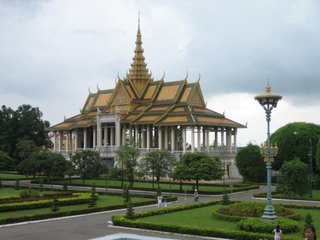
We reached Phnom Penh from Siem Reap by flight. The first thing I noticed was the improvement made in the airport complex. It was just a small hall during my last visit. Now it has two floors with an ethinic frontage of sloped tiled roof. I just could not help comparing with our sad airport at bangalore.
The capital city is just any other dirty, over crowded city with lot of unruly traffic and haphazard development. I could see lot of new bunglow type houses with big gates and barbed wire fencing. I just remembered what our Bengali friend once commented seeing the private houses in Jullundar in the late seventies. 'vulgur display of wealth'.
Our guide here was much quieter compared to our earlier guide. We could make out that both our guides were quite concerned about their country as the new government has many people who were part of the old regime of polpot.
Pol pot regime was a reign of terror. He took over the Govt. around 1975. He was a communist supported by china. He made all the educated people doctor, teachers, engineers and so on to leave the capital and asked them to till the lands. He believed that all should be farmers and no body should be educated at all! One whole generation did not receive any education at all. Many of the educated were killed simply because they were educated and many families were killed, even if one member was suspected to be a supporter of old regime. No body suspected the horror which was to come and it all came suddenly, out of the blue and almost one third population was killed by him.
People were asked to move to country side and were told they can return in a week or so but they did not know they were never to return to their homes. Many died in the hardships of the community farming and also starvation as all the produce went to the govt.
After his reign ended around late seventies or early eighties, by the support of vietnam, (they tried to exploit them is entirely a different story) it took years for the normalcy to return to the country.
We could make out , that guilty have been just allowed to go scot free. Now there is a tribunal formed but the witnesses are few and far and the govt. is not wanting to give any support to bring the guilty to the international court.
Pol pot hid in the jungles and died a natural death in 1998 and was never brought to trial for the atrocities he committed on his own people
We were taken to Toul Sleng genocidal museum , a high school turned to a torture and interrogation centre during the regime. This I had seen earlier also. Here they have kept the rooms and other things as it was , and we could see lot of devices used to torture the people. Each one brought to this centre was photographed after they were brought here. As the photographs were not destroyed it has been displayed. We can see small children and old people also and we can make out that they were not aware of the fate which was awaiting them.
Some snaps as to the condition of the prisoners when the vietnamese came here also has been taken by them and it is pathetic to see the condition of the prisoners to say the least.
Only six people survived in this centre.
Last time I saw a place where they had found mass grave and the skulls of the victims were kept in a glass 'stupa' like structure. There was a book written about this mass killings 'killing field'.(I am not sure of the title) A movie also was taken based on this book.
Now people are worried that this part of their history is being brushed under the carpet and they very much want the next generation to know what had happened to the people.
Now the country is ruled by a coalation govt. The country had a king by name 'Naroddham' and he fled the country when polpot took over. He has retired now and his son is in politics and part of the coalation govt and another son has taken over as King who is just a figure head.
We saw the king's palace and museum. The palace was very much like the Bangkok palace in Thailand but I remembered Satya emphasising again and again that the culture was transferred from Khemer to Thai and not vice versa.
We visited a museum and a Buddhist temple and also a market where we had to bargain but they never got upset but kept smiling and if the price was very low they refused to sell.
While leaving for the airport there was a traffic jam and some diversion which left us worried about our reaching the airport on time.
At last we reached the airport.
The impression I got after seeing and hearing about the horrors, is that Human beings as a Species can go to the zenith of glory and also to the other extreme of reaching the nadir. We feel the universe was created for us and we tend to exploit nature, other species and even our own species.
I hope Combodia which has such abundant natural resources, big rivers which look almost like sea and fertile land , recreates its past glory and develops into a lovely nation.
Thursday, May 04, 2006
Angkor 3
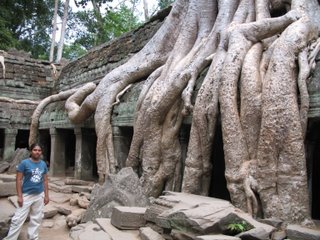
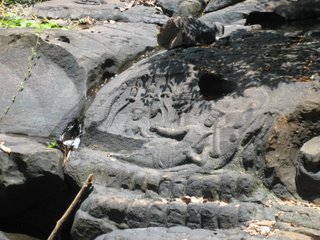
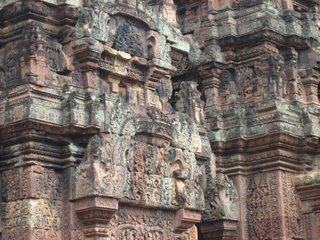
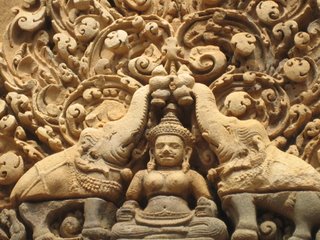 Well on day 2 we did visit some other sites which were in ruins (of course) and went to the local market. We could see some apsara figures, the Bayon king figures and even lot of ganesha made in wood, metal and stone. We did some shopping of titbits and we were told to bargain upto 40 percent. Here every body understands english and have communicative skills and with their small calculator it was easy to bargain. Of course no need to mention that the trade was strictly in american dollars. I wonder if even in USA so much transaction is done in dollar bills.( As it is just plastic or internet transaction there)
Well on day 2 we did visit some other sites which were in ruins (of course) and went to the local market. We could see some apsara figures, the Bayon king figures and even lot of ganesha made in wood, metal and stone. We did some shopping of titbits and we were told to bargain upto 40 percent. Here every body understands english and have communicative skills and with their small calculator it was easy to bargain. Of course no need to mention that the trade was strictly in american dollars. I wonder if even in USA so much transaction is done in dollar bills.( As it is just plastic or internet transaction there)Well today being day 3 we were heading towards the outskirts of the city about 30 to 40 kms away from the city. One of our friends was very particular about this visit as we were to visit the sahastra linga site.
First on our way we stopped at the site Banteay Srei. (On our way, we saw many more structures and just took pictures as we did not have time.) This is also built in sand stone but here the sand stone has a red hue and has wonderful carvings much better than the angkor group. It has intricate designs which reminded me very much of Belur and Halebidu temples near bangalore. (I have decided to revisit belur and halebidu). This is also in ruins of course.
This was a temple dedicated to siva with a shrine for vishnu and brahma also. But there are no shrines now. We could see the figures of siva and parvathi on nandi the umamaheswara posture, unfortunately the parvati's head is cut. we could see, indra on iravata, the vali sugriva fight, narasimha killing hiranyakasipu and many more carvings. This has only one level.
The scenery is wonderful with big trees, on both sides of road and lot of cashew trees on the way. Our guide was telling us how polpot after his fall was hiding in the forest near here and how this place was full of land mines after the vietnam war ended in the end of seventies. He said there were like 2 mines for each combodians living. Luckily thanks to the organization which Princess Diana took a lot of interest in and other organizations, now almost all of the mines have been removed.
We reached the base of the Kulen mountain. We had to climb up the mountain to a place Kbal Spean where the thousand lingas are found. The guide said it is just half an hours climb. But for some of us it was more than that and the terrain at some places was really tough. We did manage to climb to the top and there initially it was a dissapointment to see the small area in which the lingas are found. Water flows over the lingas which are carved out of the rocks and during rainy season the whole lot of lingas are sumberged in water which could be seen (he said) if there is sunlight. But for us being dry season only little water was flowing over the lingas and we could see carvings on the side rocks of vishnu in his sleeping posture with lakshmi near his foot and also brahma on a lotus from his navel. there was uma maheswara also carved nearby. The visnu with lakshmi was sort of a repetitive theme which could be found on rocks nearby near the stream some five or six of them. Our guide was explaining vishnu with his leg massage lady lakshmi. (there are lot of massage and leg massage centres in Siem Reap). There is a little water fall also. This symbolically represents the Meru mountain and river ganga. So we all had the water sprinkled (prokshana) on our head. To some Australian visitors, one of our friends showed the carvings as otherwise it is not very conspicuous to a normal visitor without a guide.
Getting down was much more tough though it was faster. We had lunch in the base of the hill which was set in a beautiful surrounding just simple tiled roof hall. It had a wonderful orchard which had mangoes just hanging fives and sixes in a bunch and jack fruits all around us. Our guide was so hospitable he wanted us to taste their delicacy. So he had bought gluttonous rice on the way and made them cook it, and had bought some local mangoes. you are too eat the cooked gluttonous rice with the mangoes which is the dessert. It is entirely a different story that we could not wait for the normal rice to arrive as we were hungry and had the gluttonous rice with our great podis and ate mangoes separately. Of course I did try the gluttonous rice with mangoes and it did taste nice. He had bought ' nongu' also on the way and gave it for dessert. One thing is in every restuarant they give fresh cut fruits as dessert. pineapple is also very tasty there. It was pouring very heavily while we were having lunch and lucky that we climbed down before the rain.
We returned to angkor area again and saw another huge complex Preah Khan which was built by jayavarman VII in memory of his father. It is supposed that it was sort of an university or place of higher education at his time. Here we could see some 200 years old mahagony trees.
The next one we saw was Ta Prohm built for queen mother by the same king. This one the building is just interwined with trees, and roots. They have just kept it so that we could understand how the other buildings also were before restoration. This building restoration is being done by the archeological survey of India. We met few officers and when they asked our opinion we said some how the interwining of the trees and the buildings has such a charm which makes it look one of the most beautiful structures in the whole of our tour. So at least some of them have to be kept as it is. They said there plan is some what same as the UNO guidelines also specify this.
In the evening we went to a cultural show in a hotel, where we saw dance performance by group. There was apsara dance and some folk dances also. Just like our kolattam, they did almost with same rythm and movements, dance with polished coconut shells .
Our tour of Angkor was complete and we set out for phnom penh with heavy heart.
Wednesday, May 03, 2006
Angkor 2
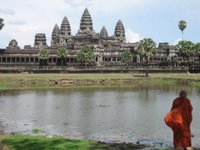
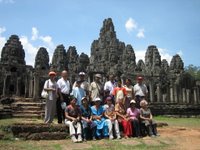
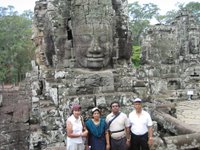
On the day 2 we visited many temples. The whole site is maintained by world heritage and the entrance fee is collected. We have to give our photos (if we don't have they click the picture there) and a photo id pass is given to each individual which is checked at every site on entry. One day, Three day and a Week's pass is given on payment. (in US dollar) the money goes to combodian company. No body is allowed to be in the site after 7 p.m. Angkor Thom is the city which has four gates inside which lots of temples have been built. Yes all of them are temples built by the Kamboja kings who practiced hinduism and later buddhism. We can see pictures and stories from every epic stories of hindu mythology and it is really overwhelming to hear the Combodian guide pronouncing the names of the mythological characters and asking us if it right! You see apsara every where in all the buildings. The four entrances to Angkor Thom have huge structure with four faces, which they have found is the face of the King Jayavarman VII. The whole records have been lost as they were in palm leaves and they are reconstructing the history using the stone carvings and also some travel documents recorded by chinese traveller(s)!
The entry to the city is through the gate which has the four faces. It is quite wide as to allow the elephants to go inside in the olden days so our bus had no problem going through it. Each gate n/s/e/w has in front of it the big naga structure the serpent vasuki which is used in the churning of the milk of ocean in our mythology. One side we can see the devas and the other side of the entrance the asuras holding the 7 headed serpent. The heads of many of these demons and devatas have been cut and we are told they have been taken for private and other collections.
This vasuki structure appears to be the theme of modern Siem Reap as we see these in the latest structures also.
Two important sites are to be mentioned. one was the temple with the four faces of the king which is called as Bayon temple complex. Though it is all in ruins it is overwhelming to see the benign face smiling at us from every direction and level possible. It appears there are more than 200 faces in that structure.
The second one is the Angkor Wat which is the world famous structure. This has three compartments for the Hindu trinity God brahma , vishnu and siva. Even now we can see a big statue of vishnu. Inside wall of this building is carved with lot of mythological stories where we could recognise, siva, rama, ravana, skanda, krishna and many many more of our mythological characters .
The building has five distinct stupas which are carved like the closed lots petals.
This building has multiple structures and it has buddhist shrine in the highest level and prayers are being offered even now.
Combodia is a buddhist country now majority of the population being buddhists.
The structures are built with sand stone. It is quite tough to climb up all the levels as the steps are narrow and broken in parts. But we did go to the highest level.
The whole culture and the technology of temple building was probably transferred from South India when the traders used to come to old kamboja for trading purposes. Those days they had to travel in the sea with the help of wind and they could go in the direction in which the wind blew. It used to take 6 months for the wind to change direction and they could start back the homeward journey only at that time. So it is asssumed that they had to stay in kamboja for the whole period (max six months) and that is how the buildings are so distinctly Indian.
The artisans might have come to South India and learnt the style of the buildings. But it is distinctly angkor though it has so much of Indianness. For four five centuries this place practiced hinduism.
Tunle Sap lake
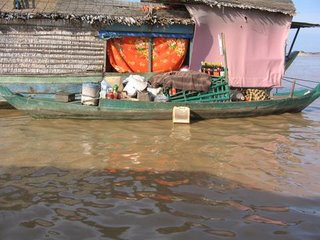
On the day one of our trip to Ankhor we were taken on a boat ride on the Tunle sap lake. We had arrived at Siem Reap at 12 noon and after lunch we set out for the ride. I had heard so much about the temple ruins and the Ankhor wat and other temples, I wanted to see them and I was wondering what is there to see in a lake.
We were taken to a canal in a bus. We had to travel on a very muddy and uneven road. We were transferred to a motor boat. A small boy was helping the driver of the boat in navigating the boat using a long oar. We were asked to be careful, keep our hands inside as there were other boats which were manoeuvring in the other direction very near our boat.
The guide was talking non stop about the old kings and the new political kings while I was wondering about the whereabouts of the lake.
Suddenly there appeared a huge lake dotted with lot of stationery swaying boats.
The guide told us that this is a special lake, which makes the direction of a river change. I simply could not comprehend. Then he explained. This lake which we were visiting in the dry season is fed by the waters of the river Mekong which flows from the base of Himalayas (Tibet) to the capital Phnom penh. During rainy season which starts in May and continues for 6 months the level of this lake increases and some where in October due to the increase in the level the water reverses and the Mekong river goes back from here to Phnom Penh.
The roads on which we rode in the bus which were lined with trees including mango trees on both sides, will be completely submerged in water during rainy season when the water level increases upto 9 meters that is well above those trees. The trees come out unscathed after the water recedes.
Lots of fish are brought into the lake from the Mekong and the fish find a good breeding place in the submerged trees . Hence the abundance of fresh water fish here is one of the highest in the world.
Once the water starts receding the whole area is so fertile that they grow the rice crop by just sprinkling the seeds without the need for ploughing or even replanting.
We could find two colonies or group of boat houses in the lake. The guide saod that one side i viet namese and the other combodians. We could see lot of boats with rooms with curtains, kitchen and even small gardens. We even saw a pig pen attached to a boat with few pigs in it!
Natural question was what will happen to the houses in these waters when the water level increases. He said the houses are either boats or they are built on bamboos which are tied together. So these people move their houses as the water level increases are decreases. Then only we noticed that virtually the boats were on leash tied to some stick like arrangement lest they move away in the wind. He said the lake will fillup the whole area upto the base of the hill which we could see a little distant away and the people will move there houses accordingly. We could see some shops also selling some items for the people living there.
We were taken to a shop which had a viewing platform as well as shops with local artefacts. This also had a small crocodile and a fish farm!
The guide had told us not to encourage beggars as they are trained to beg and are not sent to schools. We saw a little boy tagging along in our boat begging with tears in his eyes. when the boat picked up speed to our astonishment he jumped from the boat and we could see his head pop up in a little distance away.
Survival! Kids learning to swim in water automatically , as we learn to walk. It is hard to imagine living one's whole life in water where you keep shifting your house every now and then.
This was just a slum in a big lake. But the seasonal changes, which the guide explained and the guides narration made the visit a worthwhile visit.
I would like to visit this place in rainy season and see the area as our guide mentioned it is unrecognizable and this place needs two sets of maps one for dry season and one for rainy season.
I find it so difficult to understand the concept of changing direction of the river I would like to physically see the river changing the direction and moving the other way.
Tuesday, May 02, 2006
Angkor 1
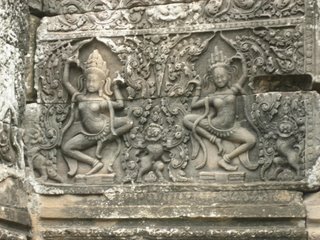
I am back from a trip to Angkor. It is indeed a wonderful experience to see the (ruins) anceint Hindu culture in a South Eastern Country so far away from India.
It all started two months back when a friend of mine told me they are going on a trip to Angkor and Phonm Penh in Combodia. I had visited Combodia Phnom Penh about 8 years back but at that time did not have time to visit Angkor. We were 17 in our group 5 of them children, and the average age of the elders in our group was roughly 60!!
We took a flight from KL to Siem Reap the city where the Angkor site is found. We were met by a guide at the airport whose name was 'satya', a very pleasant gentle man. I was surprised to see the street leading out of the airport lined with lovely hotels on both sides. I had heard in my last visit that in the Angkor area facilities are not much. I was amazed at the improvement. We were put up in a nice hotel in the centre of the city which looks as though it just lives for the sake of the vast number of tourists. It is a bubbling small city which has an Indian restuarant too. Though there is a local currency whole transaction is made in US dollars only. So we all had lot of small denomination like 1 and 5 dollar bills as we did not want to get back the change in the local currency and it might be too heavy ! to carry as one dollar is some 5000 local currency.
Since majority in our group were vegetarian we had told repeatedly we need some vegetarian food. We did get different varieties each day some leaf and vegetable, but managed with some 'podi' which we had carried with us. We did get rice every where and we got some yogurt from the super market also. Since food was included in the package everything was arranged and we got to eat in the Indian restuarant for one day lunch.
Angkor had a great Khmer civilization empire beginning roughly around 8th century AD till 14th century which saw the peak in 12th century when the king Jayavarman VII built big temples and buddhist shrines. Many other kings also contributed to the building spree in the Angkor.
The kingdom ended as it was over run by the neighbouring Siam (Thailand) and the capital shifted to more safe Phonm Penh . All these things got lost to mankind due to the buildings covered and ruined by tropical forest and vandalism by greedy men but luckily restoration started from the middle of last century by French who were occupying the country. But some of the artifacts were taken (stolen? ala Kohinoor) by French and we were told some of them are displayed at the famous Louvre museum in Paris. Combodia got independence in 1953 and the restoration work continued. But unfortunately during the terror regime of the tyrant polpot all work stopped for 10 years and now the restoration work is progressing in leaps and bounds thanks to the site being declared as a world heritage.
we were told by the guide that in ancient times, there were three great civilization in Asia, India in south asia, China in the East and Combodia or Kambhoja as it was called, in the south East Asia.
Indeed it does seem it is true when one completes the tour of the anciet ruins in the Angkor area.
Subscribe to:
Posts (Atom)